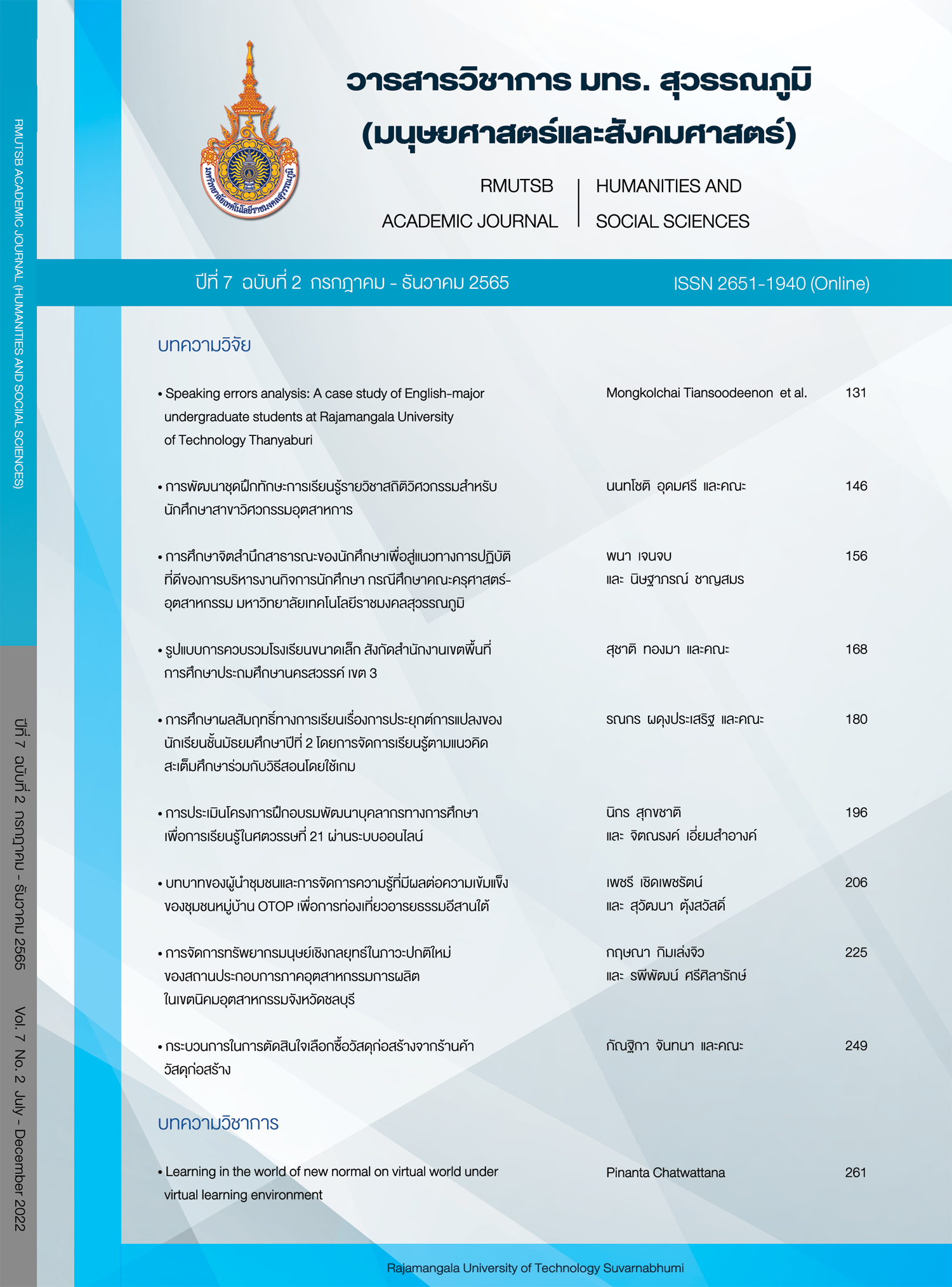Speaking errors analysis: A case study of English-major undergraduate students at Rajamangala University of Technology Thanyaburi
Main Article Content
Abstract
English speaking is an essential communication skill that Thai learners face difficulties in improving. This study aimed to investigate the types of English-speaking errors made by Thai undergraduate students when speaking English and identify the sources of such errors. The population included 133 Thai sophomore students who enrolled in the Presentation in English course in the first semester of the academic year 2021. Twenty-four participants were selected by a purposive sampling method. The data was collected using a speech error identification form adapted from Clark & Clark's concept, which was validated by three experts in English learning and identified the sources of errors according to Dulay, Burt, & Krashen. Frequency and percentage distribution statistics were used to analyze the data. Inter-raters validated the errors consisting of two native English speakers and one Thai teacher. The results revealed that the most frequently found speech errors were filled pauses, stutters, and repeats, respectively. The misformation was the most frequently found, followed by the omission of "be" and the addition of "be" in the sentences as grammatical errors. Each type of error results from one of the three sources of errors, which are cognitive, psychological, and sociological reasons. The pedagogical implications from this study could be applied in designing teaching and learning processes to develop students’ speaking skills.
Article Details

This work is licensed under a Creative Commons Attribution-NonCommercial-NoDerivatives 4.0 International License.
References
Alkan, H., & Bümen, N. T. (2020). An action research on developing English speaking skills through asynchronous online learning. International Journal of Curriculum and Instruction, 12(2), 127-148.
Akkakoson, S. (2016). Speaking anxiety in English conversation classrooms among Thai students. Malaysian Journal of Learning and Instruction, 13(1), 63-82.
Bashir, M., Azeem, M., & Dogar, A. H. (2011). Factors affecting students' English speaking skills. British Journal of Arts and Social Sciences, 2(1), 34-50.
Boonkit, K. (2010). Enhancing the development of speaking skills for non-native speakers of English. Procedia-Social and Behavioral Sciences, 2(2), 1305-1309.
Chania, S., & Amri, Z. (2019). An analysis of students’ grammatical errors on speaking at SEA debate at English Department of Faculty of Languages and Arts of Universitas Negeri Padang. Journal of English Language Teaching, 8(4), 515-521.
Chunngam, B., & Worasesthaphong, T. (2018). A procedure of local wisdom: learning, transferring, and utilizing social media. RMUTSB Academic Journal (Humanities and Social Sciences), 3(2), 215-228.
Clark, H. H., & Clark, E. V. (1977). Psychology and language: An introduction to psycholinguistics. New York: Harcourt Brace Jovanovich.
Crystal, D. (2003). English as a global language. Cambridge: Cambridge University Press.
Dayat, D. (2017). Analysis on English speaking performance: Exploring students’ errors and the causes. Journal of Education, Teaching and Learning, 2(1), 71-74.
Dulay, H. C., Burt, M. K., & Krashen, S. D. (1982). Language two. Oxford: Oxford University Press.
Evans, V. (2017). Why English is such a difficult language to learn. Psychology Today. Retrieved January 15, 2022, from https://www.psychologytoday.com/us/blog/language-in-the-mind/201702/why-english-is-such-difficult-language-learn#:~: text=All%20languages%20have%20idioms% 2C, 20.
Fadhila, H., Fauziati, E., & Haryanti, D. (2013). Errors in speaking English made by students of English Department of Muhammadiyah University of Surakarta (Doctoral dissertation). Universitas Muhammadiyah Surakarta, Surakarta.
Gass, S. M., & Mackey, A. (2013). Stimulated recall methodology in second language research. New York: Routledge.
Harmer, J. (2015). The practice of English language teaching: Teachers at work (5th ed.). Harlow: Pearson.
Jaiyai, S., Torwong, P., Usaha, S., Danvirattana, A., Luangthongkam, S., & Piyadamrongchai, R. (2005). The existing situations and problems relating to foreign language teaching and learning in the northeastern part of Thailand (Educational Region 5). Bangkok: The Thailand Research Fund.
Khamkhien, A. (2010). Teaching English speaking and English speaking tests in the Thai context: A reflection from Thai perspective. English Language Teaching, 3(1), 184-190.
Kusirirat, K., & Nuchprayoon, N. (2022). The effects of learning activities by project-based learning on agile approach to integrate workpiece productivity in Digital Media Sequencing and Editing Course. RMUTSB Academic Journal (Humanities and Social Sciences), 7(1), 120-130.
Leaduwee, A. (2018). The English speaking difficulties of Thai student in ma'had al-jami'ah: Sociolinguistics perspective (Doctoral dissertation). IAIN Palangka Raya, Palangka Raya City, Central Kalimantan.
Lightbown, P. M., & Spada, N. (2006). How languages are learned (3rd ed.). Oxford: Oxford University Press.
Martina, F., Akbarjono, A., Friantary, H., & Sari, T. N. P. (2021). Investigating English students’ motivation in speaking class during new normal era. Journal of English Education and Teaching, 5(3), 436-452.
Marzec-Stawiarska, M. (2015). Investigating foreign language speaking anxiety among advanced learners of English. In M. Pawlak, & E. Waniek-Klimczak (Eds.), Issues in teaching, learning and testing speaking in a second language (pp. 103-119). Heidelberg: Springer Berlin Heidelberg.
Nation, I. S. (2001). Learning vocabulary in another language. Cambridge: Cambridge University Press.
Navidinia, H., Mobaraki, M., & Malekzadeh, F. (2019). Investigating the effect of noticing on EFL students' speaking accuracy. International Journal of Instruction, 12(1), 83-98.
Noom-Ura, S. (2013). English teaching problems in Thailand and Thai teachers' professional development needs. English Language Teaching, 6(11), 139-147.
Onkao, J. (2020). The development of an English instructional model based on the concepts of multisensory and hands-on & minds-on for the ticket officers at Ayutthaya Historical Park. RMUTSB Academic Journal (Humanities and Social Sciences), 5(2), 219-235.
Sasum, S., & Weeks, B. (2018). Why some Thai students cannot speak English fluently. Proceedings of RSU International Research Conference 2018 (pp. 361-367). Pathumthani: Rangsit University.
Savaşçı, M. (2014). Why are some students reluctant to use L2 in EFL speaking classes? An action research at tertiary level. Procedia-Social and Behavioral Sciences, 116, 2682-2686.
Suthiwartnarueput, T. (2017). The effects of impromptu speaking practice on English speaking ability of Thai EFL students. Journal of Institutional Research South East Asia, 15(1), 106-120.
Touchie, H. Y. (1986). Second language learning errors: Their types, causes, and treatment. JALT Journal, 8(1), 75-80.
Trent, J. (2009). Enhancing oral participation across the curriculum: Some lessons from the EAP classroom. Asian EFL Journal, 11(1), 256-270.
Widodo, P. H. (2014). Methodological considerations in Interview data transcription. International Journal of Innovation in English Language, 3, 101-107.


